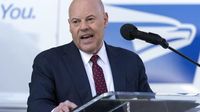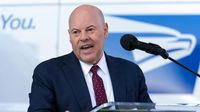The U.S. Postal Service (USPS) is grappling with uncertainty in its leadership following the resignation of Postmaster General Louis DeJoy, effective March 24, 2025, after nearly five years in the role. DeJoy's departure comes amidst significant unrest among postal workers who have been protesting recent operational changes and budget cuts.
DeJoy, who took on the role in the summer of 2020 during Donald Trump's presidency, had indicated months prior he would step down but had not set a specific date until his resignation became public. He has been a controversial figure, described by many as the first postmaster general in nearly two decades without a postal service background, having previously run a logistics business and been a significant donor to Republican causes.
His tenure was characterized by efforts to reform and modernize the USPS amid declining revenues and rising operational challenges. In recent statements, DeJoy had announced plans to cut 10,000 jobs and billions from the agency’s budget, a move he claimed was necessary to sustain a positive trajectory for the organization. In the face of backlash from postal employees and community members who feared that these cuts would dismantle services, protests took place over the weekend leading up to his resignation.
“The future of the Postal Service is on the line, and choosing someone with innovative ideas and appreciation for our Constitutionally mandated service is essential,” said Brian L. Renfroe, president of the National Association of Letter Carriers. His statement reflects the growing concern among USPS employees regarding the path forward for the agency.
With DeJoy stepping down, Deputy Postmaster General Doug Tulino will temporarily assume leadership until a permanent replacement is appointed by the USPS Board of Governors. DeJoy noted, “I believe strongly that the organization is well positioned and capable of carrying forward and fully implementing the many strategies and initiatives that comprise our transformation and modernization...” This optimistic sentiment contrasts starkly with the growing anxieties among the USPS workforce, which constitutes approximately 640,000 employees nationwide.
Notably, in February, DeJoy had requested assistance from what has been termed Elon Musk’s Department of Government Efficiency (DOGE) to help with several of the agency's challenges. This collaboration raised concerns over plans that some critics believe could lead to privatization or merging USPS with the Commerce Department. These suggestions have been met with stern opposition from various legislative figures, including Democratic Representative Gerald Connolly from Virginia, who warned that such moves could seriously undermine the postal service's constitutionally mandated roles.
DeJoy's leadership had been defined by dramatic shifts aimed at addressing the postal service’s long-standing financial troubles, which last year led to a loss of approximately $9.5 billion. By proposing significant workforce reductions and budget cuts, he aimed to reduce forecast cumulative losses over the next decade from $160 billion to $80 billion.
DeJoy’s controversial tenure was framed by the logistical heft of the COVID-19 pandemic, growing international mail demands, and the historic surge in mail-in ballots during election cycles. These factors placed inevitable stress on the agency, making it more challenging to balance service quality with budgetary constraints effectively. Many postal workers feel that the adjustments made under DeJoy eroded service reliability and accessibility.
The discussions surrounding DeJoy's exit are occurring against a backdrop of broader proposals by former President Trump, who has notably supported measures to overhaul the USPS’s operational framework. His administration had floated ideas where USPS's operations might be merged with the Commerce Department to streamline services—an idea critics fear could disrupt established practices and further diminish service standards.
Many stakeholders are now awaiting the selection of DeJoy's successor, eager to see if the new leadership will shift the course of the USPS towards a more stable and inclusive model, one that addresses both the operational issues and the needs of its vast workforce. As postal workers continue to rally against potential cuts, the urgency of restoring confidence in the agency’s mission remains paramount.
DeJoy's resignation not only marks the end of a controversial chapter in postal service history but also signifies a critical juncture for the USPS. The newly appointed postmaster general will need to navigate through turbulent waters, balancing financial necessities with the expectation of restoring public trust and service integrity.
While uncertainties abound regarding the future direction of the USPS, the defining question that lies ahead is how the agency will adapt and transform amid these systemic pressures and the voices of a passionate workforce determined to protect their service from further erosion. Without a focused strategy, the USPS risks losing its footing in an ever-changing landscape that increasingly favors privatization over public service.







